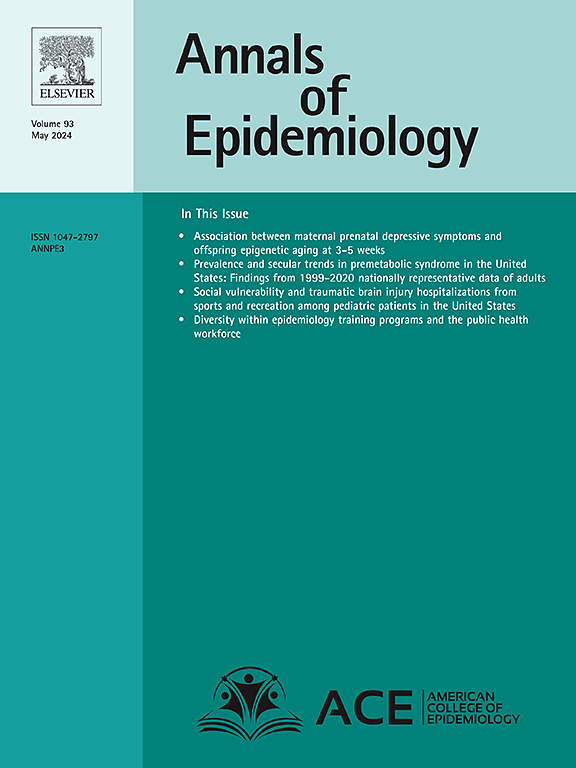妊娠糖尿病、体重指数和心脏代谢多病症:前瞻性队列研究
IF 3
3区 医学
Q1 PUBLIC, ENVIRONMENTAL & OCCUPATIONAL HEALTH
引用次数: 0
摘要
目的 妊娠期糖尿病(GDM)会增加罹患 2 型糖尿病(T2DM)和心血管疾病的风险。然而,有关妊娠糖尿病与心脏代谢多病症(CMM)之间关系的证据却很有限。本研究旨在评估 GDM 与 CMM 的患病率、发病率、模式和进展之间的关系,以及体重指数(BMI)在这种关系中的作用。截至 2020 年 12 月 31 日,GDM 和心血管代谢疾病(包括中风、冠心病 [CHD] 和 T2DM)的诊断由参与者报告,或通过与住院患者数据的连接获得。体重指数在基线评估时进行评估。CMM定义为患有两种或两种以上所包含的心脏代谢疾病。采用逻辑回归模型和Cox比例危险模型评估GDM与CMM之间的关联,并评估BMI对这种关联的影响。GDM与较高的CMM患病率(几率比[OR]=4.64,95 % 置信区间[95 % CI]=3.54-6.08)和发病率(危险比[HR]=3.62,95 % CI=2.62-5.00)相关。特别是,GDM 与 T2DM、T2DM 与血管疾病并存以及 T2DM 后患血管疾病的几率较高相关。对效应修正的正式测试表明,BMI 对 GDM 与 CMM 事件之间的关联有乘法修正作用。我们的研究结果表明,孕产妇干预和生活方式干预(如体重管理)可用于 CMM 的一级和二级预防,尤其适用于有 GDM 病史的妇女。本文章由计算机程序翻译,如有差异,请以英文原文为准。
Gestational diabetes mellitus, body mass index, and cardiometabolic multimorbidity: A prospective cohort study
Purpose
Gestational diabetes mellitus (GDM) could increase the risks of type 2 diabetes mellitus (T2DM) and cardiovascular disease. However, evidence on its association with cardiometabolic multimorbidity (CMM) was limited. This study aimed to evaluate the association between GDM and the prevalence, incidence, patterns, and progression of CMM; and the role of body mass index (BMI) in such association.
Methods
This study included 203,372 women who have given birth in UK Biobank. The diagnoses of GDM and cardiometabolic diseases (including stroke, coronary heart disease [CHD], and T2DM) were reported by participants or obtained through linkage to inpatient hospital data until 31st December 2020. BMI was assessed at the baseline assessment. CMM was defined as having two or more of included cardiometabolic diseases. Logistic regression models and Cox proportional hazard models were used to assess the association between GDM and CMM, and the modifications on both additive and multiplicative scales were assessed to evaluate the effect of BMI on such association.
Results
A total of 1217 women had a history of GDM, 2351 participants had CMM at the end of follow-up and 1601 was newly diagnosed during follow-up. GDM was associated with higher prevalence (odds ratio [OR]=4.64, 95 % confidence interval [95 % CI]=3.54–6.08) and incidence (hazard ratio [HR]=3.62, 95 % CI=2.62–5.00) of CMM. In particular, GDM was associated with higher odds of T2DM, coexisting T2DM and vascular disease, and T2DM followed by vascular disease. Formal testing for effect modification suggested multiplicative modification by BMI for the association between GDM and incident CMM.
Conclusions
GDM was associated with CMM in women’s late life, with multiplicative modification effects of BMI. Our results suggest that maternal and lifestyle interventions (e.g., weight management) are warranted for the primary and secondary prevention of CMM, particularly in women with a history of GDM.
求助全文
通过发布文献求助,成功后即可免费获取论文全文。
去求助
来源期刊

Annals of Epidemiology
医学-公共卫生、环境卫生与职业卫生
CiteScore
7.40
自引率
1.80%
发文量
207
审稿时长
59 days
期刊介绍:
The journal emphasizes the application of epidemiologic methods to issues that affect the distribution and determinants of human illness in diverse contexts. Its primary focus is on chronic and acute conditions of diverse etiologies and of major importance to clinical medicine, public health, and health care delivery.
 求助内容:
求助内容: 应助结果提醒方式:
应助结果提醒方式:


